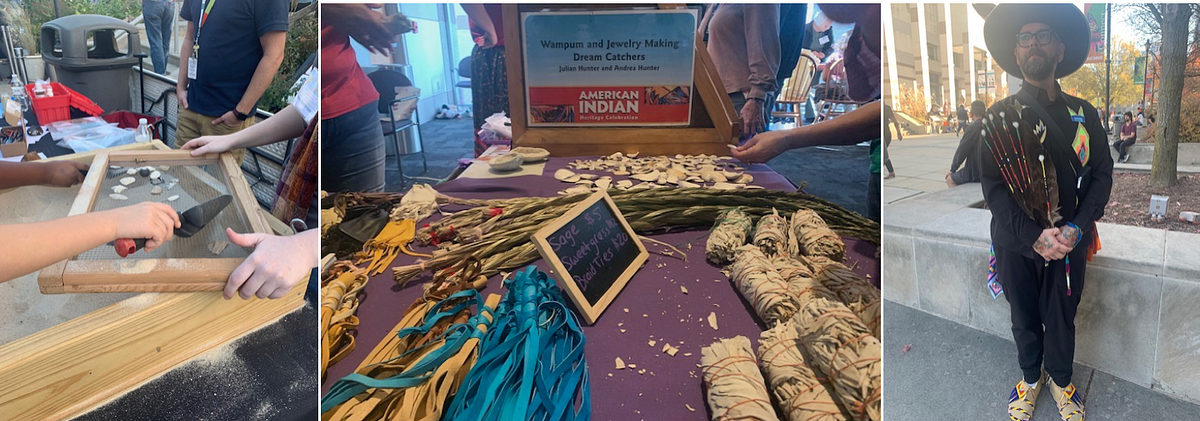Raleigh/ Durham/ Chapel Hill
Tribal Celebration: “We’re Still Here”
by | Nov 28, 2023 11:53 am
Post a Comment | E-mail the Author

Synclaire Cruel Photos
Scenes from the annual celebration; Seth Turner, at right, came up from Florida for the gathering.
Annual American Indian Heritage Celebration
North Carolina Museum of History
Raleigh
Nov 18, 2023
The dancers stood in the center of the stage, facing a full crowd of onlookers. The drummers sat on the right and began playing a steady beat as a person chanted into a microphone that echoed throughout the plaza. Then, with a shuffle, the dancers began moving rhythmically along to the music. Depending on the dance, the performers could be seen using a fan or wearing a shawl. In other instances, you could hear the jingles attached to their regalia tinkering along, matching their movements. It amplified the sound of the performance, enabling visitors to get lost in the story, message, or prayer they were conveying.
These dances, chants, drumbeats and colorful regalia filling the grounds at the North Carolina Museum of History for the annual American Indian Heritage Celebration exploded with themes of unity, connection, resiliency, and strength. One particular message was made clear: “We are not a people of the past, we’re still here.”
By exploring storytelling circles, musical and dance performances, and the artwork on display, visitors could immerse themselves in a space to learn about tribes in North Carolina.
“Seeing the different tribes come together as one is a big deal and something I would love to see again,” said Alexis Lowry, from the Lumbee Tribe and the first Miss North Carolina Indigenous Ambassador.
At the entrance, guests were greeted by lively presentations; the walkway was lined with activities for kids. Spaces were set up for an archaeological dig, pottery imprinting, and making a coil pot. There was ample opportunity to engage with vendors, authors, and artists inside the museum.
The festivities began with the Blessing of the Grounds, followed by drum songs and a roll call of 15 state recognized tribes and organizations. Inside, vendors sold handmade cooking utensils, hunting and fishing tools, artwork and jewelry, and braid ties and sage, which one helper referred to as a “cloak of positivity.”
“The culture here [North Carolina] is a lot different from what I’m used to, so it’s really good to have that cross-cultural experience of the tribes and be connected,” said Seth Turner of the Siksika tribe of the Blackfoot Nation and the Lakota Tribe, which are in the regions of Montana and South Dakota.
Dancers then took center stage. Each performance began with an explanation of the origin of the dance, its significance and, at times, the accompanying regalia. Southeastern Woodland Social dances were performed by the Lumbee Tribe, which is the largest tribe east of the Mississippi River; and the Coharie Tribe, which spans parts of Harnett and Sampson counties. Visitors got to witness the Catava Bear Dance, a partner dance, and the Mosquito Dance, a crowd favorite. It tells the story of how the Creator took pity and got rid of a giant mosquito that used to terrorize their people but left behind its babies, which still plague the state today.
Quickly thereafter, the Iroquois Smoke Dance was performed by the Meherrin Tribe, which straddles the Virginia-North Carolina border.The dancers began with a slower footwork, that gradually got faster. They bounced, moved, and turned in symmetry around each other throughout the stage. Sometimes in circles, other times in a pathway they carved out for themselves. It’s a dance that warriors would do the night before a battle to demonstrate how they would get their enemies; now it’s a social dance. It starts off slow and gradually speeds up. A feeling of gratitude washes over visitors in these moments. Experiencing the ties that bind them to their history was a privilege.
Lowry donned traditional women’s regalia that was originally designed by Hayes Alan Locklear for Natasha Tilson when she competed in and won the National Miss Indian USA contest in 1993. It now features the color green, which represents scoliosis. Lowry was diagnosed with the disease in 2019. Flowers and Intricately designed patchwork with the four colors of the tribe, red, black, yellow, and white, which represents the four seasons, could also be found on her regalia. “I love flowers and floral plants because it represents to me, the person and their growth in life,” Lowry said.
Turner drove up from Daytona Beach, Florida with his younger brother to attend the celebration and play the drums. “Participating in this event is good for the soul,” he said.
“A lot of these guys [drummers] travel in powwow circuits throughout the year, so we get to see each other all around the country sometimes, and it’s just good to build those friendships and network.”
Turner said he aims to decolonize modern contemporary fashion. He wore a black matching set that had traditional patchwork with designs that are all hand-sewn, and traditional moccasins. “I’m a big fan combining indigenous traditional clothing and modern things,” he said.
Some classes at the gathering focused on how tribes keep their traditions alive. Others highlighted personal stories, traditional symbols and tattooing, and how to make sweet sorghum. That agricultural tradition is currently being revived within the Coharie Tribe. Absorbing this information provided a glimpse into their beliefs and efforts to preserve and document their history; visitors only needed to have an openness and willingness to learn.
“Seeing our culture still being practiced, especially with all the little kids running around and learning and educating the public about it, is saying hey, “we’re still here and we still have our culture,” Turner said. National Native American Heritage Month ends Nov. 30.